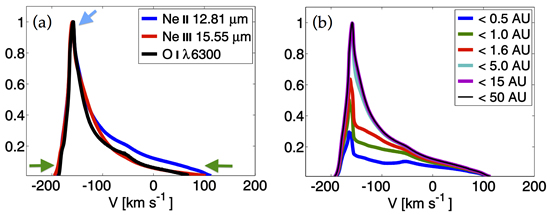研究成果藝廊 > 理論天文物理理論天文物理
(Theory)
研究成果藝廊
理論天文物理理論天文物理
(Theory)
| Neon Fine-Structure Line Emission from the Outflows of Young Stellar Objects |
|
圖片來源: Hsien Shang et al.

Figure (a) shows the normalized line profiles of the Ne II 12.81um (blue), Ne III 15.55um (red), and the O I 6300 (black) lines for a X-Wind jet modeled for a typical T Tauri star, at an inclination angle of 45 degrees. Figure (b) shows the contribution of the Ne II line as a function of cylindrical distance to the jet axis.
|
The forbidden transitions of ionic neon have been proposed to trace gas content of X-ray irradiated circumstellar disks due to their high ionization potentials. They can also be generated in the complex environment surrounding the young stellar object, as young stars are prominent X-ray emitters. We show that jets from young stellar objects, long known to emit forbidden optical lines of heavy atomic/ionic species such as O I (atomic oxygen), also generate mid-infrared transitions of Ne II (singly-ionized neon) and Ne III (doubly-ionized neon).
Figure (a) shows the normalized line profiles of the Ne II 12.81um (blue), Ne III 15.55um (red), and the O I 6300 (black) lines for a X-Wind jet modeled for a typical T Tauri star, at an inclination angle of 45 degrees. At this inclination, the line profiles present two features suggesting their outflow origin: 1) a broad wing from -200 to +100 km/s, indicating the acceleration region of an outflow [indicated by the green arrows], and 2) a strong blueshifted peak pointing at the projected value of the wind terminal velocity [indicated by the blue arrow]. Figure (b) shows the contribution of the Ne II line as a function of cylindrical distance to the jet axis. The emission is mainly built up and generated within 5 AU from the central star. These features reflect some of the unique properties of the X-wind model of outflows from young stellar objects that can be distinctively resolved by high-dispersion echelle spectroscopic observations. (Shang, Glassgold, Lin and Liu 2010, ApJ, 714, 1733) |
 asiaa.sinica.edu.tw 媒體連絡: epo
asiaa.sinica.edu.tw 媒體連絡: epo asiaa.sinica.edu.tw
asiaa.sinica.edu.tw